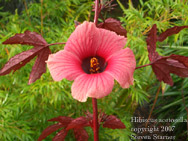 Hawaiian Tropical Plant Nursery, LLC
Hawaiian Tropical Plant Nursery, LLC
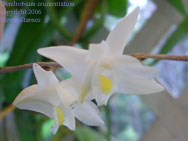
 Hawaiian Tropical Plant Nursery, LLC
Hawaiian Tropical Plant Nursery, LLC

To Order Visit our online store:
http://www.store.hawaiiantropicalplants.com
We ship to all 50 states.
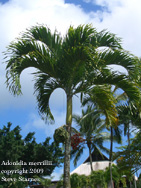 |
Adonidia merrilii-(syn. Veitchia merrilii) Common Names: Manila Palm, Christmas Palm. Very ornamental tropical palm native to the Phillipines. Very popular landscape plant in Hawai'i and South Florida. Arching pinnate fronds and light green crownshaft. Full sun. Large bright red fruits are ornamental. Reaches about 20 to 25 ft. tall after many years. Benefits from the addition of dolomite to potting mix or planting area. Full sun. Hot temperatures. Best at lower elevations in Hawaii. Seeds are relatively large. Young plants are slow growing for the 1st couple of years. |
| Archontophoenix cunninghamiana 'illawara'hardy king palm. Very ornamental species native to Australia. The hardiest member of this genus. Reportedly survives hard freezes to 22 degrees F. Relatively fast growing. | |
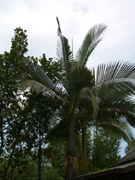
|
Archontophoenix purpurea-Common Name: Purple King Palm. Robust species with purplish crownshaft. Trunks of mature palms reach 50 to 60 ft. tall and up to 18 inches in diamter. Seeds are larger than A. cunninghamiana and A. alexandrae. Large clusters of reddish fruit are ornamental. Native to rainforest of North Queensland in Australia. This species is slower growing than other Archontophoenix species |
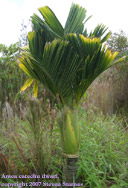
|
Areca catechu- Common Name: Betel nut palm. Tropical Asian palm with green crownshaft and pinnate leaves. There are dwarf and semi-dwarf forms available. The dwarf form is pictured to the left. The dwarf form has yellow to gold fruit that seems to be slightly smaller than the standard form. The standard form can reach up to 100ft. tall. Grown for seeds which are used a strimulant. This is a very attractive palm. Grows best in warm humid areas. Does not appear to be cold tolerant. Germination is rapid (for palms). My dwarf A. catechu bloomed in 2007 & 2008 but set only a few seeds in 2008. |
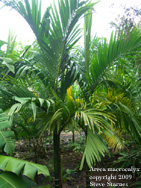
|
Areca macrocalyx- Family: Arecaceae. Common Name: highland betel nut. Used as a substitute for A. catechu. Native to New Guinea. Reported to grow at a higher elevation. Plants are smaller reaching only about 20 ft. in height. Prefers some shade. Moist rich soil. Fertilize several times per year. Composted chicken manure followed by chelated iron and magnesium works well. I have well established plants and finally have them blooming (September,2009);unfortunately no seed set yet this year. |
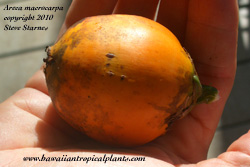
|
Areca macrocarpa- Family: Arecaceae. Medium sized palm native to the Philippines. Grown as a substitute for betel nut. Fruits are large. Single trunk that begins to fruit at a shorter size than A. catechu. Internodes are closer together than in A. catechu. Some references note that this is a clumping species. |
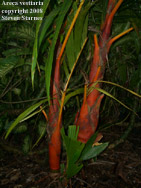 |
Areca vestiaria- Several color selections of this palm are available in Hawaii. The maroon form has new leaves which are deep red and turn dark green upon maturing. Crownshaft is red. Other selections have orange or gold crownshafts and deep green leaves. I have the maroon form and a form with an orange crownshaft. This clumping palm requires medium shade; early morning or late afternoon sun is ok. This is one of my favorite palms. Requires tropical conditions. Slightly acid rich soil. Keep moist or water during prolonged dry periods. |
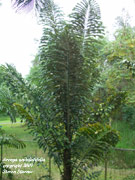
|
Arenga undulatifolia- Clumping palm that reaches height of 20 ft. Pinnate leaves to 10 ft. long Margins of leaflets are wavy. Native to rainforest of the Philippines, Borneo and Indonesia. Full sun or light shade. |
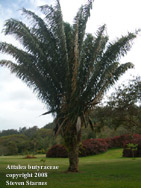
|
Attalea butyraceae- Common Names: Canambo. Striking large palm with huge leaves. Leaves are erect. Large fruits are processed for high quality oil. Native to Southern Mexico, Central America and Northern parts of South America. Full sun. Tropical humid growing conditions. Outdoors in Zones 10 to 11. I have access to a plant that fruits several times per year. Inquire for seeds or check the online store: http://www.store.hawaiiantropicalplants.com |
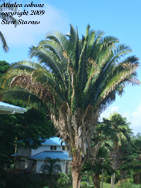
|
Attalea cohune- Common Names: Cohune palm. Striking large palm with huge leaves. Almost identical in appearance to A. butryaceae. The fruits are large and contain a single large seed. Easy to distinguish when seeds are present on the plants Leaves are erect. Seeds are processed for high quality oil. Native to Southern Mexico, Central America and Northern parts of South America. Full sun. Tropical humid growing conditions. Outdoors in Zones 10 to 11. I have access to a plant that fruits several times per year. Inquire for seeds or check the online store: http://www.store.hawaiiantropicalplants.com |
| Bactris gasipaes- Common Name: Peach Palm. Large clumping palm native to tropical rainforest of South America. Widely cultivated for edible large orange fruit. Palm heart is edible and good quality. Since it is a clumping species, palm heart can be harvested sustainably. Leaf bases and petiole are covered with long spines. However, there are spinless forms available. Tropical conditions. Slightly acid soils. Prefer applications of iron and magnesium to maintain dark green color. Seems to become a bit chlorotic in Hawaii. Prefers a steady supply of moisture and high humidity. Growth rates are very fast under ideal conditions. | |
| Bactris setulosa- Medium clumping palm native to Ecuador. Thin layer of edible pulp around the seeds.Young plants maintain juvelnile leaf form (undivided) for several years. Petiole has spines. Best with some shade when young. Soil high in organic matter is best. Fertilize and mulch lightly several times per year. Plants are best in areas with high humidity. I don't expect this species to tolerate frost. However, I have read that plants from higher elevations in the Andes will tolerate cooler temperatures than other Bactris species. | |
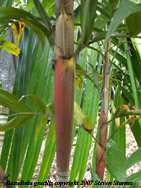
|
Basselinia gracilis- Small clumping palm native to New Caledonia. Develops a reddish crownshaft. Pinnate leaves. Very ornamental. Good in containers or in small yards. Prefers some shade. Young plants are somewhat slow growing but worth the wait. Benefits from ocassional light applications of dolomite. |
| Burretiokentia hapala- Native to New Caledonia. Relatively fast growing once established. Plants have a dark green brownish crownshaft. Nice pinnate leaves and light grey ringed trunks. Inflorescence is fuzzy and quite interesting. Reaches about 60 ft. tall. Seems to benefit from light applications of dolomite. Young plants are slow growing and can be maintained in a container for a number of years. I've heard that this species can be grown in warmer areas of California. | |
| Burretiokentia veillardii- Native to New Caledonia. Relatively fast growing once established. Plants have an intricately patterned bulging crownshaft. Nice pinnate leaves and light grey ringed trunks. Reaches about 60 ft. tall. Seems to benefit from applications of dolomite. Best in areas with low humidity. Very young plants are suseptible to disease in our very wet rainforest environment. However, once they reach about 1.5 to 2 years old they seem to be more resistant to fungal and baterial diseases. Seems to benefit from applications of dolomite. | |
| Butia capitata- Jelly palm. Ornametal bluish pinnate leaves. Edible yellow fruit. Can be maintained in containers for a number of years. Hardy to about 12-15 degrees F. Hardy to zone 8 with some protection. Needs bright light. Native to Southern Brazil and Argentina. . | |
| Butia yatay- Similar to the above species. Fruits are reported to be larger. Full sun and well drained soil. Drought tolerant once established. Tolerant of a variety of soil types. Native to South America. Also cold tolerant and can be grown outdoors in Zone 9 or possibly even Zone 8B. | |

|
Caryota mitis-Common Names: Clumping Fishtail Palm. Wide distribution in southeastern Asia and Indonesia. This species is a popular interior plant. Bi-pinnate leaves. Robust and fast growing once estatblished. Doesn't seem to require too much care once established. Mulch lightly and fertilize several times per year for faster growth. Plants in containers require regular fertilization to maintain deep green color. Tolerates very little cold and is suitable outdoors in USDA Zones 10B and 11. When a stem flowers and seeds mature that stem will die. But there are usually many younger trunks growing to replace it. |
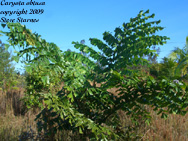
|
Caryota obtusa-Common Names: Giant Fishtail Palm. Formerly Caryota gigas. Wide range from India to southern China. This species that can become quite large. Bi-pinnate leaves. Robust and fast growing once estatblished. Doesn't seem to require too much care once established. Mulch lightly and fertilize several times per year for faster growth. Tolerates cool temperatures and moderate frost. Plants seem to tolerate temperatures in the upper 80s during the summer with no problem. I have the Indian form which may be more cold tolerant than the Thai form; probably worth tryin as far north as San Francisco. Plants are monocarpic (die after flowering and seed production) but it takes many years for the plants to mature. I'll have plants available in 2010. |
| Caryota ophiopelis- Snake skin fishtail palm. The petiole has an interesting snake skin pattern. Very unusual and rare. Medium to light shade. Rich organic soil. Tropical requirments. We don't have any data on cold tolerance for this species. Probably ready to ship in the summer. The young seedlings seem to be very slow growing. This species has been difficult for me. Seems to be a bit picky in its nutritional requirements. As with all Caryota species with a single trunk, this one is monocarpic (dies after blooming and producing seeds); but it takes many years for the palm to mature. | |
| Caryota urens- Common Name: toddy palm, jaggery palm. Native to southern India and Sri Lanka. The juice from trunk or the inflorescence is used to make sugar (jaggery) or fermented (toddy or wine). Mature plants reach up to 40 ft. tall and a foot or more in diameter. Requires moist rich soil reqular application of fertilizer for fastest growth. Plants will be available in 2010. | |
| Ceroxylon alpinum- Common Name: Andean wax palm. Native to Ecuador and Colombia at elevations around 5,000 ft.. Tolerates cool temperatures but probably not frost. Trunks have a white waxy coating. Pinnate leaves are dark green above and white underneath. I have a small batch of seedlings but they are slow growing when young. So I expect to have plants ready to ship in 2011. | |
| Chamaedorea ernesti-augustii Dwarf palm from Central America. Leaves are entire with a deep V shape. Needs shade. Similar appearance to C. geonomiformis. This one does well as a houseplant. | |
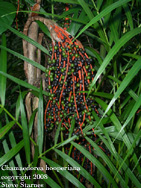
|
Chamaedorea hooperiana- Elegant clumping palm native to rain forest near Veracruz, Mexico. Grows at elevations from about
3,000 ft. to 4600 ft. Best with some shade. In hot climates it requires shade or the leaves will burn on hot sunny days. Relatively fast growing. Well
drained slightly acidic soil. I have a plant that produces seeds several times per year. Seeds are available and plants will be available in 2009. Order online: http://www.store.hawaiiantropicalplants.com |
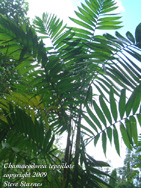 |
Chamaedorea tepejilote- Common Name: Pacaya. Central American palm that can grow up to 27 ft. Pinnate leaves are medium green and crown shaft develops. Does very well indoors surviving bright indirect light. Male inflorescence is eaten in Central America. Inflorescence is harvested just before the sheath splits. This palm has performed very well for me indoors in a container. Relatively fast growing once planted in the ground. Needs regular applications of fertilizer. Best with some shade. May tolerate brief periods near freezing. Outdoors in Zones 10 to 11. We will have plants available in the late summer or fall of 2010. |
| Chamaedorea woodsoniana- Large robust species native to Mexico and Central America. Very young plants are delicate with thin leaves. As plants become larger, leaves become tougher. Young plants require medium to dense shade. After plants reach 2 ft. tall, they can tolerate more intense sun. Keep moist. Rich slightly acid soil. | |
| Clinostigma ponapensis- Large palm native to mountains on the island of Pohnapei. Mature plants can reach 60 ft. tall. Arching pinnate fronds with pendant leaftlets. Large light green crownshaft. May develop stilt roots at the base. Fast growing. Tolerates full sun from a young age. Keep moist. Fertilize regularly for the most rapid growth. | |
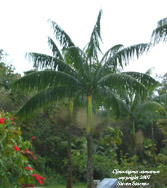
|
Clinostigma samoense-Large palm similar to the above species. Native to Samoa. Growth is fast. Light grey trunk. Large light green crownshaft. Large pinnate leaves with pendant leaflets. |
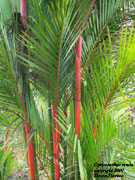 |
Cyrtostachys renda- Common Name: sealing wax palm. Clumping palm native to Southeast Asia. Bright red leaf bases make this a very colorful palm. Green trunk with white rings. Very tropical. Full sun or light shade. Young plants are very slow growing and may take 4 or 5 years to develope good color. I have access to plants that are in seed several times per year. Call or email for availability or check my online store: http://www.store.hawaiiantropicalplants.com |
| Dioon edule- A medium sized Mexican cycad with edible nuts. Tolerates light frost. Needs lots of light and good drainage. Can be grown outdoors in California ( in warm areas) or southern Florida. Attractive deep green foliage. This species is very slow growing. Can be maintained in a container for many years with no problem. | |
| Dypsis Decaryi-Triangle Palm. Native to Madagascar. Leaves are arranged in 3 ranks to form a triangle. Good in containers. | |
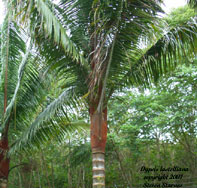
| Dypsis lasteliana- Common Name: red neck palm, col rouge. Pinnate leaves are held erect. Base of the trunk is broad. Crownshaft is covered with dark reddish to black "fur". Cape Masoala form seems to be darker than the more common reddish form. Slow to Moderate growth rate. Full sun or light shade. Well drained Soil. Native to Madagascar. Slow growing and can be maintained in a container for many years. Plants take 6 or 7 years to deveop a trunk above ground. |
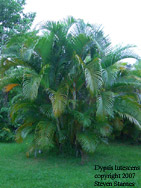
| Dypsis lutescens- Common Names: Areca palm, golden cane palm, butterfly palm. Native to wet tropical forest of Madagascar. Elegantly arching pinnate leaves with yellowish petioles. Whitish or yellowish crownshaft. Forms large clumps. Very popular interior and landscape palm. Widely planted in the tropics as a hedge. Fast growing for a palm and easy to grow. Full sun. Keep moist. Plant in well drained soil. Outdoors in frost free areas; USDA Zones 10 to 11. Fresh seeds are typically available late summer and fall; a few may ripen at other times of the year. |
| Dypsis pinnatifrons- Slender trunk topped with dark green pinnate leaves. Leaflets are wide and grouped in clusters. Good for small spaces. Looks good in light to medium shade. Moderate growth rate. Fertilize lightly and mulch for most rapid growth. Easy to grow. Requires little care. | |
| Euterpe oleraceae- Common name: assai palm. Ornamental and edible palm. Long green crown shaft. Clumping. Grown for edible palm heart. Fruits are edible and have become popular due to high levels of atioxidants. In Brazil, fresh fruit is prized as a beverage. Best in rich soil with high organic matter. It tends to show some stress during droughts when grown in lava rock and cinder (pumice). Tropical but may tolerate brief periods of cool temperatures; probably not frost tolerant. Full sun to medium shade. A selection with a striking black crownshaft has been introduced in Hawaii. Also, a dwarf has been imported and may become popular. | |
| Euterpe precatoria- ornamental tropical clumping palm American palm. Developes long green crown shaft. A variegated form of this palm is available in cultivation. Leaflets are pendant giving this palm a very elegant appearance. May have edible palm heart. . Can tolerate shade when young or full sun when more mature. Keep moist. Mulch and fertilize several times per year. Fast growing. | |
| Hyophorbe indica "red crownshaft"-Slender tropical palm. Dark maroon crownshaft when young; tends to be dark green with hints of red when mature. Pinnate dark green leaves. Full sun to light shade. Fast growing for a palm. Well drained soil. Reported to tolerate some salt spray near the coast. Fast growing. Tolerates hot windy weather and drought once established. | |
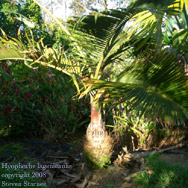 |
Hyophorbe lagenicaulis- Common name: Bottle palm. Developes a swollen bottle shaped trunk. Green slender crownshaft. Stiff pinnate leaves reach about 4 to 5 ft. long. Full sun to light shade. Well drained soil. Excellent container plant for a bright window or sunroom. Popular landscape palm in Hawaii. |
 |
Iriartea deltoidea-Large palm with plumose leaves. Seedlings have entire oval leaves. Slightly older young plants have pinnate leaves with leaflets held in a single plane; terminal leave is deltoidal. Fully mature leaves are plumose. Develops stilt roots as it matures. Growth is slow when young. Plants like plenty of moisture. Young plants seem to grow best with some afternoon shade. Mulch and fertilize for best growth. |
| Licuala elegans- Undivided circular leaves similar in appearance to L. grandis. This species tolerates wind and full sun better. Also, reported to be more cold tolerant by mainland growers. Slow growing. Can be maintained in a container for many years. Rich slightly acid soil. Partial shade. | |
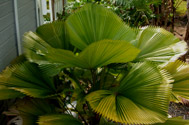
| Licuala grandis- One of the most attractive palms. Undivided circular pleated leaves and bright red fruit. Needs warm shaded conditions. Rich soil with high organic matter. Tropical. Generally doesn't tolrate prolonged cold or cool temperatures. Can be maintained for many years in a container. |
| Normanbya normanbyi- Common Name: Black Palm. Similar in appearance to the foxtail palm but with a slender trunk. The crownshaft is wider than the trunk. Native to northern Australia. Slightly acidic soil high in organic matter. Needs a fertilizer containing iron and magnesium to maintain dark green color. Full sun. Some drought tolerance once established but looks its best if irrigated during dry periods. Fertilize several times per year. Full sun when past the seedling stage. Outdoors in USDA Zones 10B to 11. Moderate to fast growth rate once established. | |
| Oenocarpus bataua- Common Name: bataua palm. Fronds of young plants are held errect. Very ornamental palm native to Brazil. Large fruits with edible pulp. Moderate growth rates once established. Full sun to light shade. This species likes to be kept moist and shows signs of stress during droughts. | |
| Oenocarpus mapora- Common Name: bacaba. Widely distributed from Costa Rica to Bolivia. Clumping or solitary trunks reach 15 to 50 ft. tall. This species has a loose crownshaft. Pinnate leaves up to 15 ft. long with wide deep green leaflets. Seems to be faster growing than O. bataua and O. distichus. Full sun once it is over a year old. Applications of iron and magnesium may be necessary to maintain deep green color. Keep moist and fertilize regularly. Out doors in Zones 10B to 11 or in the greenhouse. | |
| Phoenix humilis- Dwarf relative of the date. Trunk up to 6 ft. tall. Full sun. Well drained soil. Fruit are edible and orange to black. native to India. Cold hardy to 25 F. Young plants are slow growing. | |
| Phoenix rupicola- Cliff date. Medium sized palm native to India. Grows in rocky areas. Light shade or full sun. Purple fruits are ornamental. Survives moderate freezes. When we were in California our seedling took down to 25F with no damage. Mature plants should tolerate several degrees colder without damage. This species will make an excellent container specimen for a sunny room. Use a very well drained potting mix. Grows slowly when young. | |
 |
Pinanga caesia- Medium sized palm native to Indonesia. Crownshaft is orangish to deep red; there are several variants in cultivation. Young plants have leaves that are mottled deep and light green. Nice plant for a shady spot in the tropical garden or a good conservatory plant for a large container. I have a plant with a maroon crownshaft that has bloomed several times but failed to set seed. Outdoors in Zones 10B to 11; very little tolerance for cool or cold temperatures. |
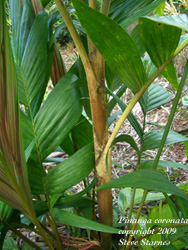 |
Pinanga coronata- Common Name: Ivory Palm. Plants formerly classified as P. kuhlii have now been merged with P. coronata. The botanist decided that they were variants of the same species. Small clumping species with pale yellowish to cream colored crownshaft. Seeds ripen to black and contrast nicely with the pale crownsaft. Leaves are pinnate with broad segments. Shady warm conditions. Should do well a container plant with some morning sun or late afternoon sun. Slightly acidic soil. Use a slow release fertilizer. Outdoors in Zones 10B to 11. I don't expect this specie to tolerate cool temperatures. |
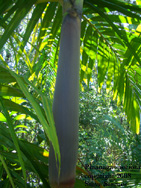 |
Pinanga speciosa-Unusual species with a purplish-black green crownshaft. Requires medium or
dense shade when young. Pinnate dark green leaves are 6 to 8 ft. long and dark green trunk ringed with white leaf-base scars. Inflorescence is red and yellow with seeds that ripen to almost black.
Native to the Philippines. Best with some shade. Soil high in organic matter. Fertilize and mulch for best growth. Can grow to 30 ft. under ideal conditions.
Can be maintained in a container for many years if you have room to accomodate the long leaves.
My 3 mature palms are blooming and setting seed several times per year. Seeds are sent when freshly available. Order online: http://www.store.hawaiiantropicalplants.com |
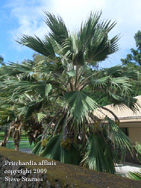 |
Pritchardia affinis- Medium sized fan palm native to the Kona district of the Big Island (Hawaii Island). Grows from sea level up to 4,000 or 5,000 ft. elevation. Due to its distribution at higher elevations, it may have some cold tolerance. It would be worth trying outdoors in Southern California and Florida. Full sun. Good drainage. Fertilize several times per year with a slow release fertilizer for most rapid growth. If growing in a container keep moist and give plenty of light. Outdoors in Zones 10 and 11. Plants are available. |
| Ptychosperma elegans-Common Name: solitaire palm. Pinnate leaves are about 6 ft. long and held erect. The crownshaft is deep green and is slightly wider than the trunk. Slender trunks reach up to 40ft. tall and 4 inches in diameter. Requires nearly full sun to look its best. Native to lowland rainforest along the northeastern coast of Australia. Seeds germinate quickly and growth is relatively fast once estabilished. This species requires warm tropical conditions. | |
| Ravenea lakatra- Native to Madagascar. Very slow to develop a trunk. Young plants have erect pinnate leaves that appear to emerge from the ground. This species is reported to develop a hard stepped trunk. Full sun. Drought tolerant once established. | |
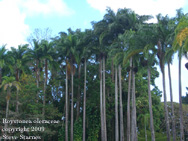
|
Roystonea oleraceae- Common Name: Venezuelan Royal Palm. Huge thick trunks topped by a 6 ft. tall crownshaft. Large plumose leaves. Unlike the Cuban royal palm, there are no bulges mid-trunk in this species. Striking large palm if you have room for it. I would recommend planting at least 20 ft. from a structure; large leaves can damage gutters if the fall on the roof. Outdoors in Zones 10B to 11. Can be maintained for a few years in a large conservatory. Plants can grow 18 to 24 inches (trunk height) a year once established. |
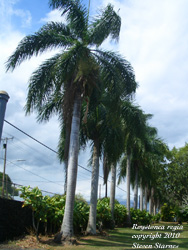
|
Roystonea regia- Common Name: Cuban Royal Palm. Widely grown in south Florida. Huge thick trunks topped by a 6 ft. tall crownshaft. Large plumose leaves. Prominent bulge in the trunk well above ground. Striking large palm if you have room for it. I would recommend planting at least 20 ft. from a structure; large leaves can damage gutters if the fall on the roof. Outdoors in Zones 10 to 11. Can be maintained for a few years in a large conservatory. Plants can grow 18 to 24 inches (trunk height) a year once established. |
| Salacca zalacca-Common Name: salk palm. Native to Indonesia and widely cultivated for its sweet fruit. Fruits are about 2.5 to 3 inches long with thin scaly skin. Large pinnate leaves are held erect. Leaflets are in groups giving a somewhat plumose look. Petioles have large spines. I'm cultivating the Balinese strain which is self fruitful; others are dioecious. Best with some shade when young. Plants grow in swampy areas and develop multiple trunks. For best fruiting, it is recommended to thin to 4 or 5 stems per plant. Not frost hardy although plants will tolerate brief drops in temperature to near freezing. Outdoors in the tropics. | |
| Syagrus romanzoffiana- Common Name: Queen Palm. This Brazilian native is one of the most widely planted subtropical palms. Large dark green plumose leaves. Trunks reach 50 ft. to 75 ft. Seeds germinate in 2 to 3 months and growth is fast. Fertilize several times per year for rapid growth. Full sun to light shade. Outdoors in Zones 9 to 11. Easy to grow. Young plants make an attractive atrium or greenhouse specimen. | |
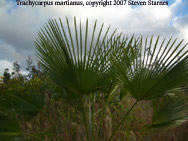
| Trachycarpus martianus- Similar to T. fortunei but larger. Fan palm native to the Himalaya. Doesn't retain leaf bases. Cold tolerant. Zone 8A or possibly Zone 7 outdoors. It seems that most Trachycarpus are growing well in USDA Zone 7. Good container subject. Full sun. Well drained soil. Can be maintained in container for many years. |
| Trachycarpus takil- This fan palm is native to the western Himalayas. It is larger than T. fortunei. Leaves are over 3 ft. across in mature plants. Fibers clothing the trunk are closely appressed. Worth trying outdoors in USDA Zone 7. Can be maintained in a container for many years. Full sun or light shade. | |
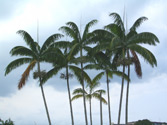
| Veitchia joannis- Common Name: Joannis Palm. Large palm native to Fiji. Trunks can reach over 100 ft. tall and 12 to 16 inches in diameter. Fronds are up to 10 ft. long with pendant leaflets. Fast growing if given adequate fertilizer. Bright red fruits are almost 3 inches long. Requires tropical conditions. |
| Wodyetia bifurcata-Foxtail Palm. Native to rainforest of northeastern Australia. Plumose leaves. Fast growing with thick trunk up to 50 ft. tall. Tolerates wind and drought. However, it does like a steady supply of nutrients. Endangered in its native habitat but is widely cultivated now. | |
| Zamia furfuracea- Common Name: Cardboard palm. A cycad native to eastern Mexico. One of the toughest and most adaptable cycds. Pinnate fronds with broad leaflets. Needs excellent drainage. Can tolerate some cool temperatures. | |
| Zamia roezlii- Deep green fronds emerge with an intense copper color and slowly turn green. This is one of the most attractive cycads. Native to South American rainforest. Usually found in wet areas. Can be maintained in a container for many years. If planted in the ground it can attain a height of 20ft. Medium shade to full sun. I think that it looks better with light shade. Outdoors in Zones 10B to 11. |
Follow us on Facebook
Frequently Asked Questions
Email: steve_starnes@yahoo.com (you will have to copy and paste the address into your email program
Steve: Cell Phone: 808-333-0505 Email is the preferred way to reach me. But if you call,
the best time to call is between 4pm and 8 pm HST.
Open by Appointment Late Afternoons and Weekends
Hawaiian Tropical Plant Nursery, LLC
P.O. Box 1511
Kea'au, Hawaii 96749